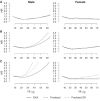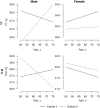The perils of using predicted values in place of observed covariates: an example of predicted values of body composition and mortality risk
- PMID: 33831946
- PMCID: PMC8326037
- DOI: 10.1093/ajcn/nqab074
The perils of using predicted values in place of observed covariates: an example of predicted values of body composition and mortality risk
Abstract
Background: Several studies have assessed the relation of body composition to health outcomes by using values of fat and lean mass that were not measured but instead were predicted from anthropometric variables such as weight and height. Little research has been done on how substituting predicted values for measured covariates might affect analytic results.
Objectives: We aimed to explore statistical issues causing bias in analytical studies that use predicted rather than measured values of body composition.
Methods: We used data from 8014 adults ≥40 y old included in the 1999-2006 US NHANES. We evaluated the relations of predicted total body fat (TF) and predicted total body lean mass (TLM) with all-cause mortality. We then repeated the evaluation using measured body composition variables from DXA. Quintiles and restricted cubic splines allowed flexible modeling of the HRs in unadjusted and multivariable-adjusted Cox regression models.
Results: The patterns of associations between body composition and all-cause mortality depended on whether body composition was defined using predicted values or DXA measurements. The largest differences were observed in multivariable-adjusted models which mutually adjusted for both TF and TLM. For instance, compared with analyses based on DXA measurements, analyses using predicted values for males overestimated the HRs for TF in splines and in quintiles [HRs (95% CIs) for fourth and fifth quintiles compared with first quintile, DXA: 1.22 (0.88, 1.70) and 1.46 (0.99, 2.14); predicted: 1.86 (1.29, 2.67) and 3.24 (2.02, 5.21)].
Conclusions: It is important for researchers to be aware of the potential pitfalls and limitations inherent in the substitution of predicted values for measured covariates in order to draw proper conclusions from such studies.
Keywords: Berkson error; all-cause mortality; bias; body composition; epidemiology; prediction equations; research methods.
Published by Oxford University Press on behalf of the American Society for Nutrition 2021.
Figures




Comment in
-
The utility of predicted values in place of directly measured body composition.Am J Clin Nutr. 2021 Aug 2;114(2):418-419. doi: 10.1093/ajcn/nqab127. Am J Clin Nutr. 2021. PMID: 33880498 No abstract available.
Similar articles
-
Predicted fat mass and lean mass in relation to all-cause and cause-specific mortality.J Cachexia Sarcopenia Muscle. 2022 Apr;13(2):1064-1075. doi: 10.1002/jcsm.12921. Epub 2022 Jan 23. J Cachexia Sarcopenia Muscle. 2022. PMID: 35068076 Free PMC article.
-
Predicted lean body mass, fat mass, and all cause and cause specific mortality in men: prospective US cohort study.BMJ. 2018 Jul 3;362:k2575. doi: 10.1136/bmj.k2575. BMJ. 2018. PMID: 29970408 Free PMC article.
-
Development and validation of anthropometric prediction equations for lean body mass, fat mass and percent fat in adults using the National Health and Nutrition Examination Survey (NHANES) 1999-2006.Br J Nutr. 2017 Nov;118(10):858-866. doi: 10.1017/S0007114517002665. Epub 2017 Nov 7. Br J Nutr. 2017. PMID: 29110742
-
Deep learning-based fully automated body composition analysis of thigh CT: comparison with DXA measurement.Eur Radiol. 2022 Nov;32(11):7601-7611. doi: 10.1007/s00330-022-08770-y. Epub 2022 Apr 18. Eur Radiol. 2022. PMID: 35435440
-
Prediction of body composition in elderly men over 75 years of age.Ann Hum Biol. 1996 Mar-Apr;23(2):127-47. doi: 10.1080/03014469600004352. Ann Hum Biol. 1996. PMID: 8702212 Review.
Cited by
-
Estimation of Absolute and Relative Body Fat Content Using Noninvasive Surrogates: Can DXA Be Bypassed?J Clin Pharmacol. 2023 Nov;63 Suppl 2(Suppl 2):S35-S47. doi: 10.1002/jcph.2306. J Clin Pharmacol. 2023. PMID: 37942909 Free PMC article.
-
Dietary Protein Intake Is Positively Associated with Appendicular Lean Mass and Handgrip Strength among Middle-Aged US Adults.J Nutr. 2021 Dec 3;151(12):3755-3763. doi: 10.1093/jn/nxab288. J Nutr. 2021. PMID: 34494110 Free PMC article.
-
Simple cardiovascular risk stratification by replacing total serum cholesterol with anthropometric measures: The MORGAM prospective cohort project.Prev Med Rep. 2022 Jan 27;26:101700. doi: 10.1016/j.pmedr.2022.101700. eCollection 2022 Apr. Prev Med Rep. 2022. PMID: 35141116 Free PMC article.
References
-
- Lee DH, Keum N, Hu FB, Orav EJ, Rimm EB, Willett WC, Giovannucci EL. Comparison of the association of predicted fat mass, body mass index, and other obesity indicators with type 2 diabetes risk: two large prospective studies in US men and women. Eur J Epidemiol. 2018;33(11):1113–23. - PubMed
Publication types
MeSH terms
LinkOut - more resources
Full Text Sources
Other Literature Sources
Miscellaneous

